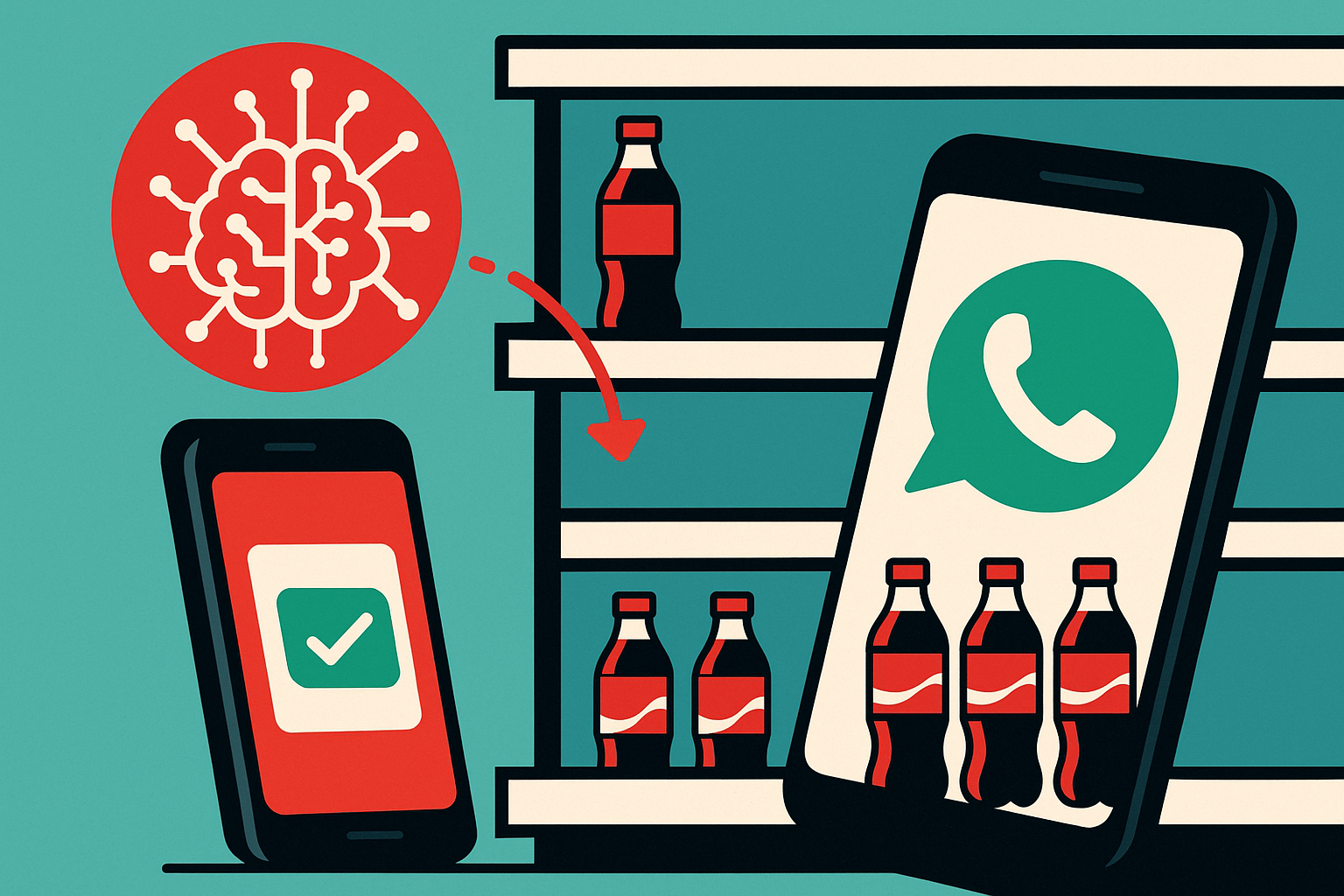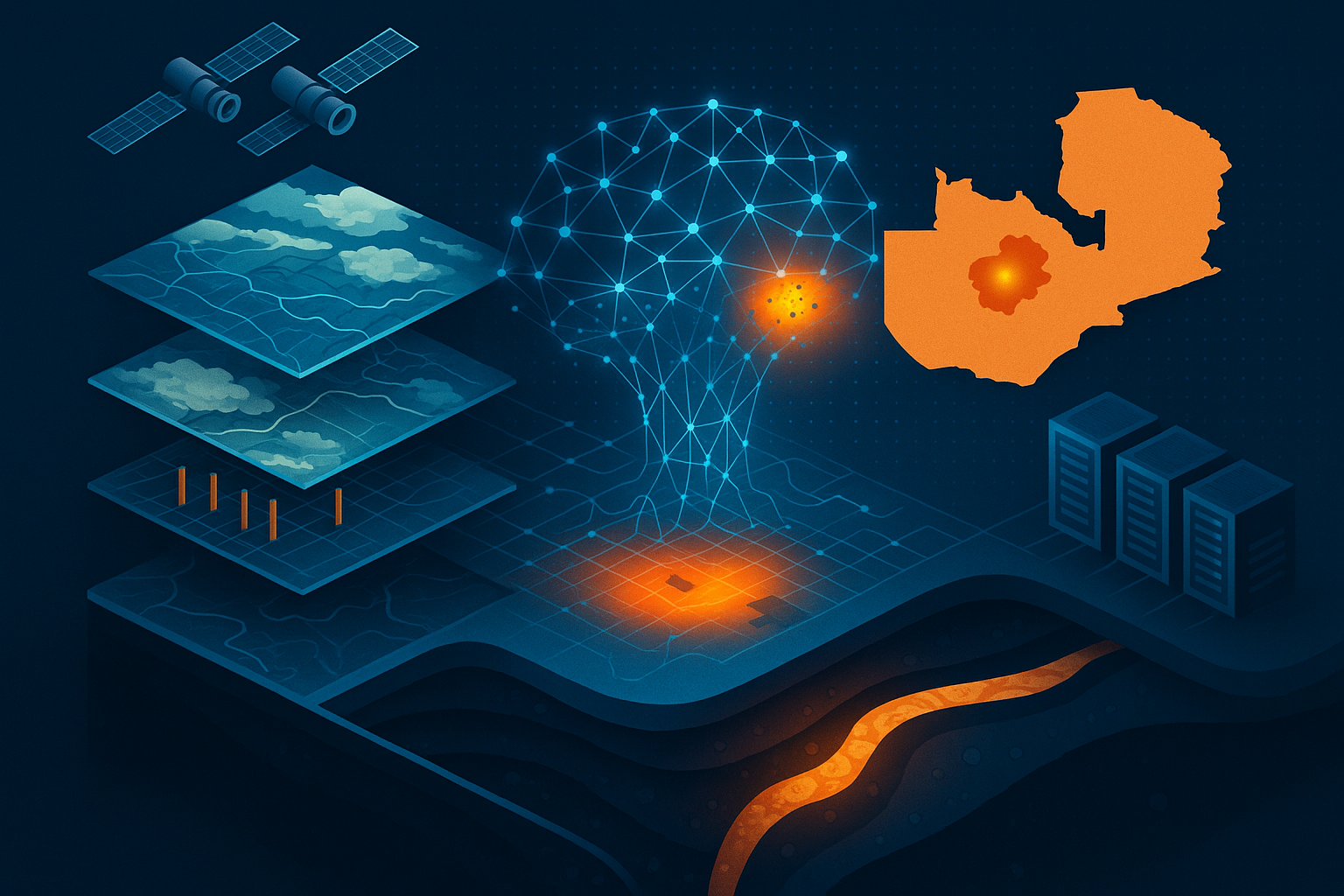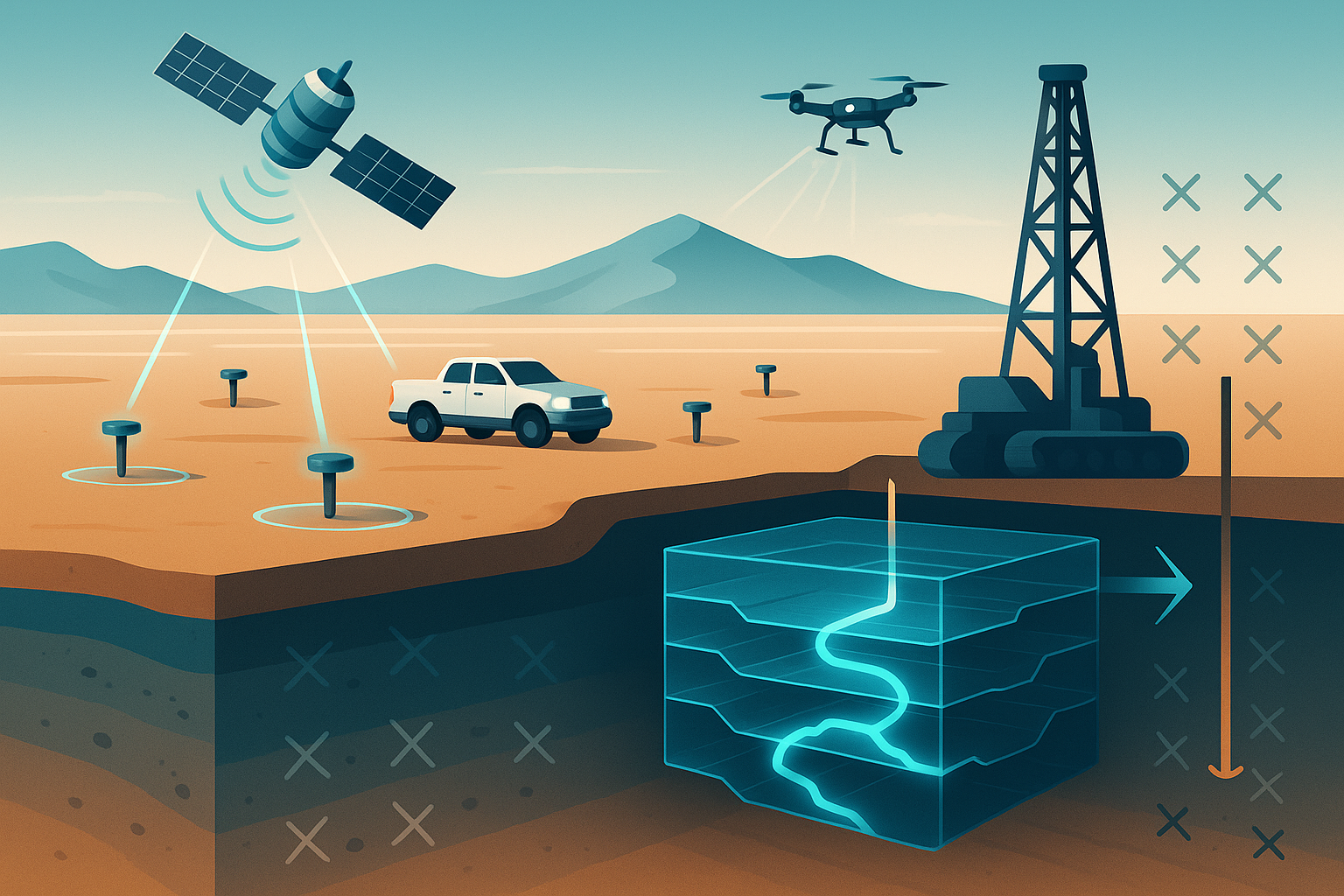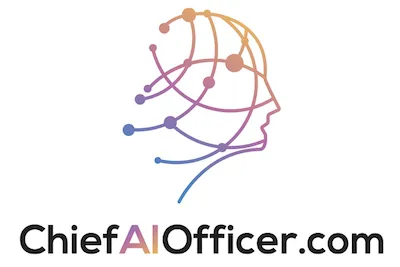Coca-Cola ran a pilot program where AI sent WhatsApp messages to retail managers telling them exactly when to restock specific products. Not generic inventory alerts. Precise recommendations: “Restock Coke Zero 500ml now, you’ll run out by 3pm Thursday based on current sales velocity and weekend demand patterns.”
The results: 7-8% sales increases in participating stores. Not from new product launches, marketing campaigns, or promotional pricing. From ensuring products were available when customers wanted to buy them. The AI predicted demand patterns with 90% accuracy, up from 70% with traditional forecasting methods.
Here’s the counterintuitive part: Coca-Cola’s biggest revenue opportunity wasn’t better advertising or new flavors. It was solving the mundane problem that stores frequently ran out of their products during peak demand periods, losing sales to competitors whose products remained available. The AI didn’t create demand. It captured demand that was always there but that traditional inventory management consistently missed.
The Out-of-Stock Revenue Leak
Consumer packaged goods companies lose billions annually to out-of-stock situations. A customer walks into a store wanting Coca-Cola, finds the shelf empty, and either buys Pepsi or buys nothing. That’s not a future sale delayed. That’s revenue permanently lost because consumers don’t return later to complete their original purchase intent.
The problem compounds across millions of retail locations worldwide. Every store runs out of certain products periodically. Traditional thinking treats this as inevitable: inventory management requires balancing carrying costs against stockout risks, accepting some lost sales as the cost of avoiding excess inventory.
The math creates a systematic bias toward under-stocking. A store that over-stocks ties up capital in inventory, risks product expiration, and occupies shelf space that could hold faster-moving items. A store that under-stocks loses some sales but avoids these carrying costs. Traditional inventory systems optimize for minimizing carrying costs rather than maximizing sales because the lost revenue from stockouts is harder to measure than the direct costs of excess inventory.
This creates an interesting dynamic for brands like Coca-Cola. They don’t directly control retail inventory decisions. Store managers or chain-level buyers decide ordering quantities based on their inventory management objectives, which prioritize their costs over Coca-Cola’s revenue. A stockout costs Coca-Cola a lost sale but might actually benefit the retailer if they sold a higher-margin competitor product instead.
Coca-Cola’s challenge is helping retailers understand that better inventory management for Coca-Cola products benefits them too. Stores that keep popular products in stock drive higher customer satisfaction, increased foot traffic, and larger basket sizes. Out-of-stocks frustrate customers, potentially driving them to competitors’ stores that reliably stock desired products.
The traditional approach to this problem involved sales representatives visiting stores, checking inventory, recommending orders, and building relationships with managers. This works but doesn’t scale efficiently. A sales rep might visit 50-100 stores in their territory, spending a few minutes per store checking inventory and making recommendations based on their experience and intuition about that store’s patterns.
AI changes the economics completely by providing every store with effectively infinite sales representative attention. The system monitors inventory levels constantly, analyzes sales patterns continuously, and delivers precise restocking recommendations instantly. No human could provide this level of attention across millions of retail locations globally.
The 70% to 90% Accuracy Transformation
Demand forecasting accuracy improving from 70% to 90% sounds incremental until you examine what that means economically. A 70% accurate forecast means 30% of your predictions are wrong—either over-predicting demand (leading to excess inventory) or under-predicting demand (causing stockouts).
The cost of forecast errors is asymmetric. Over-prediction creates inventory carrying costs and potential waste. Under-prediction causes lost sales. For high-margin products with stable demand, the cost of stockouts typically exceeds the cost of modest over-stocking, making conservative over-forecasting optimal.
But Coca-Cola products have limited shelf life. Over-stocking creates significant waste when products expire before selling. This forces conservative inventory practices that accept higher stockout rates to avoid waste. The result is systematic under-availability of products during demand spikes.
The AI achieves 90% accuracy by analyzing factors traditional forecasting ignores or under-weights: weather patterns and their specific impacts on beverage consumption, local events affecting foot traffic, seasonal patterns at granular geographic levels, competitive promotion schedules, and historical correlations between various products’ sales patterns.
Traditional demand forecasting might consider “summer increases beverage sales” as a general rule. The AI recognizes that temperature increases above 27°C drive 15% higher sales of certain products in specific geographic regions, that humidity levels affect flavor preferences, and that this relationship varies by demographic composition of the neighborhood.
The system also learns from its own prediction errors. When forecasts prove wrong, the AI analyzes why: was there an unexpected weather change, a local event the system didn’t know about, or competitive activity affecting demand? These learnings refine future predictions, creating continuous improvement in forecasting accuracy.
I’ve seen similar forecast accuracy improvements in retail where AI systems analyzing dozens of variables simultaneously achieved predictions human buyers couldn’t match despite years of experience. The humans had better intuition about individual factors. The AI could optimize across more factors simultaneously.
The WhatsApp Interface Strategy
Coca-Cola could have built sophisticated inventory management dashboards requiring training and system adoption. Instead, they met managers where they already work: WhatsApp. This interface decision matters more than it might initially appear.
Retail managers receive constant communication via WhatsApp about deliveries, staffing, promotions, and operations. Adding AI-generated inventory recommendations to existing workflows requires minimal behavioral change. Managers don’t need to log into new systems, learn complex interfaces, or change their daily routines.
The recommendations arrive as simple text messages: “Your Sprite inventory will run out by Thursday afternoon based on current sales. Recommend ordering 3 additional cases for weekend demand.” The manager can act immediately by forwarding the message to their distributor or ignore it if they have information the AI doesn’t.
This low-friction interface drives adoption. A sophisticated dashboard that provides better insights but requires learning new systems might get ignored by busy store managers. WhatsApp messages that integrate seamlessly into existing communication patterns get read and acted upon.
The interface also enables rapid feedback. When managers follow recommendations, the AI observes whether predictions proved accurate. When they ignore recommendations, the system learns whether the manager was right to override the suggestion. This creates a learning loop that improves recommendations over time while building manager trust in the system.
The conversational nature also allows contextual adjustments. A manager might reply “Holiday weekend coming, expect higher traffic.” The AI can incorporate that context into updated recommendations, combining algorithmic predictions with human local knowledge.
The Marketing Content Multiplication
Coca-Cola generates thousands of marketing asset variations across languages, regions, and platforms using AI content creation. This scale of customization was economically impossible with traditional creative processes.
Traditional marketing campaigns require human creatives to develop concepts, copywriters to write variations, designers to create assets, translators to adapt content for different languages, and approval processes ensuring brand consistency. This pipeline takes weeks or months and produces limited variations because each additional version multiplies costs.
A global campaign might create 10-20 core assets adapted across major markets with some customization. Smaller markets or niche platforms get generic content because custom versions don’t justify the investment. The result is marketing that’s somewhat relevant everywhere but perfectly relevant nowhere.
AI content generation inverts this equation. Creating 1,000 variations costs only incrementally more than creating 100 because the marginal cost per variation approaches zero. Coca-Cola can now produce region-specific, platform-optimized, and audience-targeted variations for virtually every context where their marketing appears.
The reported 20% higher engagement with AI-generated content versus traditional content likely reflects this increased relevance rather than AI producing inherently superior creativity. When marketing messages specifically address local preferences, cultural nuances, and platform-specific formats, engagement improves regardless of whether human or AI creativity produced the content.
The “Create Real Magic” campaign demonstrated this approach by generating numerous variations of creative concepts, testing them rapidly, and scaling the most effective versions. Traditional campaigns might test 3-5 concepts before committing to production. AI-enabled campaigns can test dozens or hundreds of variations, identifying winners through rapid iteration that human creative processes couldn’t match.
The practical workflow becomes: human creatives develop strategic concepts and brand guidelines, AI generates thousands of variations within those parameters, performance data identifies the most effective versions, and the system automatically scales what works. Humans focus on strategy and brand stewardship while AI handles execution and optimization.
The Flavor Innovation Intelligence
Coca-Cola’s AI-powered vending machines and product development system creates a continuous feedback loop between consumer behavior and innovation strategy. This real-time product intelligence was impossible with traditional market research approaches.
Traditional new product development relied on focus groups, surveys, and test markets. A company might spend 18-24 months developing a new flavor, test it in limited markets, analyze sales data, then decide whether to launch nationally. This process worked but limited innovation velocity and relied on consumers accurately predicting their preferences for products that didn’t yet exist.
Coca-Cola’s smart vending machines collect real-time data about flavor preferences: which products get selected most frequently, how time of day affects choices, how weather influences preferences, and how demographic patterns correlate with flavor popularity. This behavioral data reveals preferences more accurately than self-reported surveys because it captures actual decisions rather than stated intentions.
The system also enables low-risk experimentation. A new flavor can be tested in smart vending machines across diverse locations, generating thousands of data points within weeks. If a flavor performs poorly, it disappears quickly with minimal investment. If it succeeds, Coca-Cola has confidence to scale production knowing real consumer behavior validated the product.
The AI also analyzes social media sentiment, online reviews, and trend data to identify emerging flavor preferences before they reach mainstream awareness. A regional flavor trend gaining momentum in social conversations might indicate an opportunity to develop products capturing that trend before competitors recognize it.
This combination of real-time behavioral data and predictive trend analysis allows Coca-Cola to innovate faster and with lower risk than traditional product development. They’re not guessing what consumers might want based on focus groups. They’re responding to actual revealed preferences observed through millions of daily purchase decisions.
The Microsoft Partnership Architecture
Coca-Cola’s strategic partnership with Microsoft creates a unified AI platform rather than disparate point solutions. This architectural decision matters because AI initiatives often fail due to fragmentation across incompatible systems that don’t share data or insights.
The unified platform approach means demand forecasting AI can share insights with marketing optimization systems. Supply chain algorithms can inform product development decisions. Customer sentiment analysis can influence inventory predictions. This integration creates network effects where the value of each AI application increases because it leverages insights from other applications.
Traditional enterprise IT involves separate systems for different functions: one vendor for demand forecasting, another for marketing automation, a third for supply chain optimization. These systems don’t integrate seamlessly, creating data silos and missed opportunities for cross-functional optimization.
Microsoft’s Azure infrastructure provides the scalability to process massive global datasets, the machine learning tools to develop custom AI applications, and the integration frameworks to connect Coca-Cola’s diverse systems. More importantly, it provides a platform that can evolve as AI capabilities advance rather than locking Coca-Cola into specific tools that might become obsolete.
The partnership also includes Microsoft’s expertise in deploying AI at enterprise scale. Coca-Cola doesn’t need to develop deep AI technical expertise internally. They can focus on identifying business problems worth solving while Microsoft provides the technical capabilities to build solutions.
The Predictive Maintenance Impact
AI-powered predictive maintenance across Coca-Cola’s bottling operations and equipment reduces downtime and maintenance costs while extending equipment life. This represents less visible but substantial operational improvements compared to flashier marketing applications.
Bottling equipment operates continuously under demanding conditions. Equipment failures cause production shutdowns that create ripple effects: missed delivery schedules, distributor stockouts, lost sales, and emergency repair costs. Traditional maintenance approaches use fixed schedules based on operating hours, accepting some unexpected failures as inevitable.
Predictive maintenance AI analyzes sensor data from equipment, identifying patterns that indicate developing problems before failures occur. A pump showing gradual performance degradation gets scheduled for maintenance during planned downtime rather than failing mid-production. A filling line displaying subtle anomalies gets inspected before quality issues affect product output.
The economic impact accumulates across Coca-Cola’s vast manufacturing infrastructure. A 10% reduction in unplanned downtime across hundreds of bottling facilities translates to millions in avoided lost production. A 15% reduction in maintenance costs through better timing and prevention of secondary damage compounds across massive equipment fleets.
The AI also optimizes maintenance scheduling across facilities. If multiple pieces of equipment need attention but taking them all offline simultaneously would constrain production, the system sequences interventions to minimize disruption. During seasonal demand lulls, the AI can schedule maintenance that would be too disruptive during peak production periods.
The Supply Chain Optimization Layer
Coca-Cola’s AI optimizes logistics across a staggeringly complex global supply chain: thousands of bottlers, millions of retail locations, diverse transportation methods, and constant demand fluctuations. Human optimization of this complexity is impossible. AI finds efficiencies that human logistics planners would never identify.
The system analyzes delivery routes considering current traffic, weather impacts on transportation times, vehicle fuel efficiency under various conditions, and optimal loading strategies that balance delivery efficiency with product handling requirements. A delivery truck might receive routing adjustments mid-route based on real-time traffic updates that save fuel and improve delivery timing.
Warehouse operations get optimized for both storage efficiency and picking speed. Products with correlated demand patterns get stored near each other. High-velocity items get placed in easily accessible locations. Seasonal products get staged for rapid distribution as demand approaches. The AI continuously adjusts these arrangements based on changing demand patterns.
The fuel consumption reductions alone justify the investment. Small percentage improvements in routing efficiency compound across millions of delivery trips annually, saving substantial fuel costs while reducing carbon emissions. The improved delivery reliability also reduces stockouts at retail locations by ensuring products arrive when needed.
The Competitive Moat Building
Coca-Cola’s comprehensive AI integration creates compounding advantages that become increasingly difficult for competitors to replicate. Each AI application generates data that improves other applications. Each improvement creates operational advantages that fund further AI investment. The gap widens over time rather than narrowing.
Competitors attempting to build similar capabilities face multiple challenges. They lack Coca-Cola’s accumulated data from years of AI deployment. They don’t have the established Microsoft partnership providing technical infrastructure. They must invest heavily in catch-up while Coca-Cola continues advancing their already-mature systems.
The data advantage particularly matters. Coca-Cola’s demand forecasting AI has learned from millions of retail locations across diverse markets for years. A competitor starting today cannot match that training data regardless of their technology investment. Even with identical AI algorithms, Coca-Cola’s systems will perform better because they’ve learned from more real-world examples.
The organizational capabilities also create barriers. Coca-Cola has developed expertise in deploying AI across global operations, managing change required for workforce adoption, and integrating AI systems with legacy processes. This accumulated knowledge represents intellectual capital that competitors must build from scratch.
The Digital-First Transformation
Coca-Cola’s leadership describes transforming into a “digital-first, AI-infused enterprise” rather than a traditional CPG company that happens to use AI. This framing reveals strategic thinking about AI as fundamental to business model rather than a supporting technology.
Digital-first means decisions get made based on data and AI insights rather than intuition and experience. Marketing strategies get validated through AI-generated predictions before launch. Product development priorities reflect AI analysis of market trends. Supply chain decisions optimize based on algorithmic recommendations.
This requires cultural change beyond just technology deployment. Traditional CPG companies value experience, brand intuition, and creative judgment. Digital-first enterprises respect these qualities while demanding they integrate with data-driven insights rather than operating independently.
The transformation also affects hiring and talent development. Coca-Cola increasingly needs people who combine domain expertise with data literacy and comfort working with AI systems. Marketing managers must understand both brand building and how to leverage AI tools. Supply chain professionals need logistics expertise plus ability to interpret and act on AI optimization recommendations.
The Revenue Growth Measurability
Coca-Cola’s CEO emphasizes AI initiatives that produce “tangible revenue growth” rather than just operational efficiency. This focus ensures AI investments prioritize business impact over technical sophistication.
The 7-8% sales increases from WhatsApp inventory recommendations represent clearly measurable revenue impact. The 20% engagement improvement with AI-generated marketing content translates to quantifiable customer acquisition and retention benefits. The demand forecasting accuracy improvements reduce lost sales from stockouts with calculable financial value.
This measurability matters because it justifies continued AI investment and expansion. When leadership can point to specific revenue increases attributable to AI, funding additional initiatives becomes easier. The virtuous cycle of AI success generating resources for further AI investment accelerates adoption.
The focus on revenue growth also prevents AI initiatives from becoming purely cost-reduction exercises. Efficiency improvements matter, but revenue growth drives enterprise value more powerfully than cost cutting. Coca-Cola’s approach ensures their AI investments target growth opportunities rather than just operational optimization.
The Global Scalability Advantage
Coca-Cola operates in over 200 countries through networks of bottlers and distributors. AI solutions that prove effective in one market can scale globally, multiplying their value far beyond initial deployment.
The WhatsApp inventory recommendations that increased sales 7-8% in pilot markets can potentially roll out across millions of retail locations worldwide. Even if effectiveness varies by market, capturing half the pilot results globally would translate to hundreds of millions in incremental revenue.
The marketing content generation tools that create thousands of variations can apply across all markets Coca-Cola serves. The marginal cost of extending to additional languages or regions is minimal compared to the original development investment.
This scalability creates returns on AI investment that dwarf typical enterprise software projects. A traditional IT system might provide benefits within a single business unit or geography. Coca-Cola’s AI platforms deliver value across their entire global footprint, with benefits multiplying as deployment expands.
Your Strategic Response Path
For consumer packaged goods companies, Coca-Cola’s comprehensive AI adoption creates strategic pressure. The operational advantages, marketing efficiencies, and demand prediction capabilities they’re building compound into sustainable competitive advantages. Companies delaying AI adoption risk permanent disadvantages.
Start with high-impact, measurable use cases like demand forecasting or inventory optimization where AI can demonstrate clear ROI. Early wins build organizational confidence and justify expanded investment. Avoid the temptation to pursue flashy AI applications before solving fundamental operational challenges.
Invest in data infrastructure enabling AI rather than rushing to deploy specific algorithms. Without clean data, integrated systems, and measurement frameworks, even sophisticated AI delivers limited value. The infrastructure creates a foundation supporting multiple AI applications over time.
Build internal literacy about AI capabilities and limitations across the organization. Success requires people who understand both their functional domains and how AI can enhance their work. Pure technology specialists can’t deploy AI effectively in business contexts without domain expertise integration.
Partner with established AI platforms rather than attempting to build everything internally. Coca-Cola’s Microsoft partnership provides technical capabilities and scalability that would be prohibitively expensive to develop independently. Focus internal resources on identifying problems worth solving rather than building AI infrastructure from scratch.
The Future of Consumer Goods
Consumer packaged goods is shifting from intuition-driven to AI-optimized operations. The companies that master this transition will dominate their categories through superior efficiency, better demand prediction, and more effective marketing. Those maintaining traditional approaches will find themselves permanently disadvantaged by competitors operating with fundamentally different cost structures and capabilities.
Coca-Cola proved that AI transformation in CPG isn’t theoretical. It’s operational reality delivering measurable revenue growth and efficiency improvements. The question isn’t whether AI will transform consumer goods. It’s whether your company will lead or follow in this transformation.
Increasing store sales 8% through better inventory management isn’t about revolutionary technology. It’s about solving mundane operational problems that were always there but that traditional approaches couldn’t economically address at scale.




